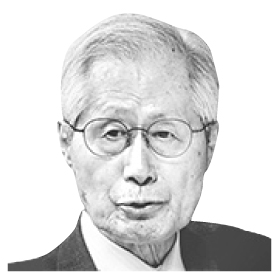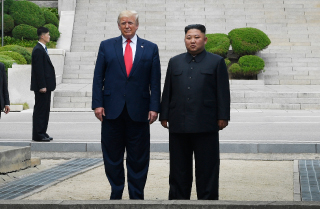Challenges from Panmunjom

The author is a former editor-at-large of the JoongAng Ilbo.
The world was shocked by the surprise meeting between North Korean leader Kim Jong-un and U.S. President Donald Trump in Panmunjom. Hu Xijin, editor in chief of China’s Global Times, called the meeting a “romance on the 38th parallel.” Still captivated by the excitement after the show, President Moon Jae-in declared that hostilities between North Korea and the United States had come to an end.
We’ll have to wait and see if that’s true. The dramatic meeting was an outcome of the friendship between Kim and Trump, built up through tweets and exchanges of letters. The personal relationship between the two leaders cannot replace national interests, Hu wrote. That is a serious warning about excessive expectations from the meeting. A romance that flares up quickly also dies quickly.
There was no discussion on the denuclearization of North Korea when Trump and Kim met at the truce village of Panmunjom. They only agreed to form negotiation teams in two to three weeks and create a framework for a denuclearization negotiation. It is essential for both sides to overcome the trauma of the failed summit in Vietnam and for the new teams to coordinate the agenda for a fourth North-U.S. summit and produce a timeline for an overall denuclearization process, which includes Washington’s reciprocal actions in return for the steps North Korea would take.

U.S. President Donald Trump and North Korean leader Kim Jong-un pause in the northern section of the truce village of Panmunjom before crossing the military demarcation line to return to the southern section on June 30. [AP/YONHAP]
On June 30, the New York Times published an article that rang alarms for South Koreans. “But for weeks before the meeting, which started as a Twitter offer by the president for Mr. Kim to drop by at the Demilitarized Zone and ‘say hello,’ a real idea has been taking shape inside the Trump administration that officials hope might create a foundation for a new round of negotiations,” it read. “The concept would amount to a nuclear freeze, one that essentially enshrines the status quo, and tacitly accepts the North as a nuclear power, something administration officials have often said they would never stand for.”
A nuclear freeze could be a step toward complete denuclearization. But when the freeze goes on too long, there is a risk that it will end up being an acceptance of the North’s nuclear arms programs. Richard Haass, president of the Council on Foreign Relations, told the New York Times that the Trump administration seemed content with the “chimera of denuclearization.”
Such concerns can’t help but arise because Washington and Pyongyang have no agreement on what denuclearization actually means. Does it mean the dismantlement of each and every nuclear warhead, every bit of nuclear materials and each and every ballistic missile? Does Kim really go along with that concept?
Agreeing on the concept of denuclearization is the foundation for the entire denuclearization process. Until now, the discussion has only focused on contents of denuclearization without the format. The two Koreas and the United States must agree that the denuclearization that will ensure the peace of the Korean Peninsula is an “exhaustive” one. As the agreements both sides have struck so far are too loose, there are too many loopholes for North Korea.
The Moon Jae-in administration must not be swayed by the frequent wishful thinking by the pessimists and cynics of denuclearization, who are presumed to take up about 90 percent of U.S. politicians, officials and security experts in think tanks. If the surprise meeting at Panmunjom evolves into a fourth Trump-Kim summit, the denuclearization negotiation will likely get accelerated fast. The challenge for Moon after the surprise meeting is persuading Kim Jong-un — who tries to exclude him from North Korea-U.S. denuclearization negotiations — to restore inter-Korean relations to the level of last year with an “imagination that goes beyond common sense” and steer the U.S.-North nuclear negotiations in the direction that South Korea wishes.
If the Panmunjom meeting develops into a fourth U.S.-North summit, denuclearization talks will enter a substantial phase. Now is the time for Moon to use the “imagination” that he has mentioned. A big deal — Washington’s easing of five major sanctions related to the North Korean people’s livelihoods in exchange for a nuclear freeze — could offer a turning point. If both sides overcome that obstacle, the next step will be the establishment of liaison offices in Washington and Pyongyang.
Because a fourth Kim-Trump summit is expected to take place in autumn, it is physically impossible to accomplish complete denuclearization by that time. Given this practical limitation, if both sides could strike a big deal before autumn, it will be a dramatic achievement for the Korean Peninsula peace process.
JoongAng Ilbo, July 8, Page 29










with the Korea JoongAng Daily
To write comments, please log in to one of the accounts.
Standards Board Policy (0/250자)